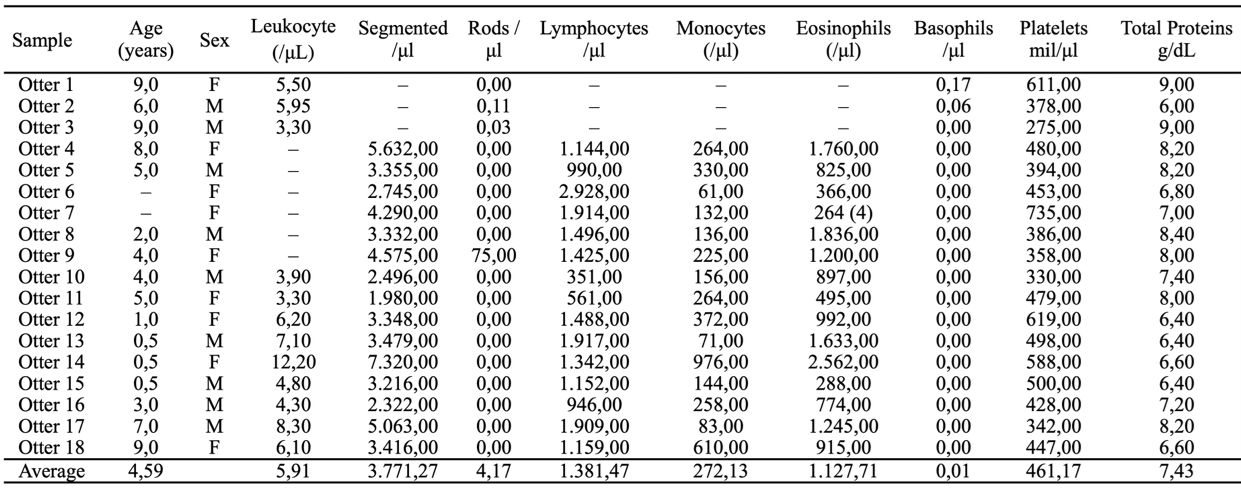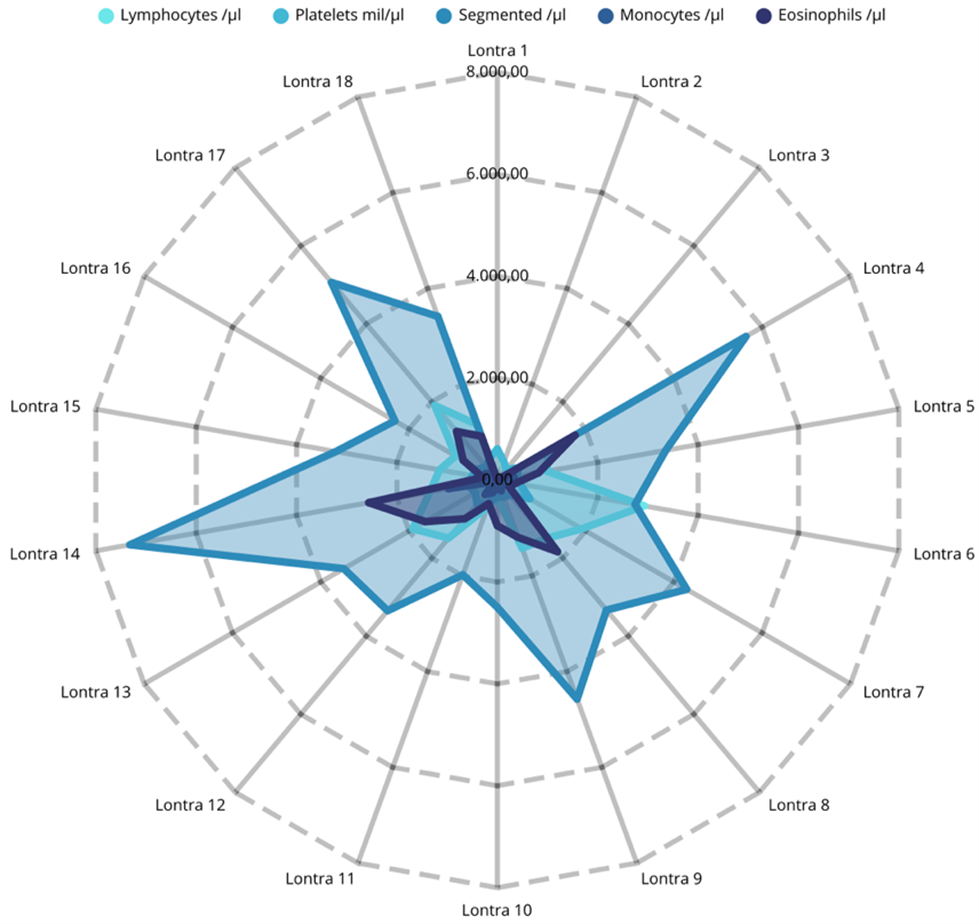IUCN/SSC Otter Specialist Group Bulletin

©IUCN/SCC Otter Specialist Group
Volume 42 Issue 4 (August 2025)
Citation: Carvalho-Junior, O., Esteves, P.S., and Tosatti, M. (2025). Hematological Profile of Neotropical Otters (Lontra longicaudis). IUCN Otter Spec. Group Bull. 42 (4): 163 - 178
Hematological Profile of Neotropical Otters (Lontra longicaudis)
Oldemar De Oliveira Carvalho-Junior*, Pricila S. Esteves, and Marcelo Tosatti
Instituto Ekko Brasil, Servidão Euclides João Alves, S/N, Lagoa do Peri, 88066-000, Florianópolis, SC, Brazil
*Corresponding Author Email: ocjunior@ekkobrasil.org.br
Received 7th July 2025, accepted 15th July 2025
Abstract: This study aimed to establish reference values for the haematological profile of Lontra longicaudis maintained in captivity, contributing to clinical evaluation, health monitoring, and conservation strategies for this endangered species. Blood samples were collected from 18 individuals of varying ages (from pups to adults) and both sexes, allowing for an initial assessment of physiological variability. The results revealed mean erythrocyte counts of 6.30 million/μl, haematocrit of 51.94%, and haemoglobin concentration of 16.39 g/dl, all within expected ranges for wild carnivores. Haematometric indices indicated a normocytic and normochromic pattern across most individuals. Leukocyte counts averaged 5.91 x10³/μl, with neutrophils as the predominant cell type, suggesting a stable immune status in the majority of animals. However, some individuals exhibited notable deviations, such as Otter 14, which showed leucocytosis, neutrophilia, monocytosis, and eosinophilia, possibly indicating an inflammatory or infectious process. Platelet counts and total protein levels were generally within normal limits, though isolated cases of thrombocytosis and hypoalbuminemia were observed. These findings provide baseline data for future comparative studies between captive and free-ranging populations. Despite the limited sample size, this research fills a critical gap in the literature and supports the development of targeted health management protocols for Lontra longicaudis. The establishment of these reference values enhances the capacity for early disease detection, improves veterinary care, and strengthens conservation initiatives for this key aquatic species in neotropical ecosystems.
Keywords: Freshwater predator, spatial ecology, non-native species, spraint analysis, mustelids.
INTRODUCTION
The conservation of endangered species requires a profound understanding of their physiology, ecology, and specific needs in different contexts, both in natural environments and in captivity. The Neotropical Otter (Lontra longicaudis), a semiaquatic mammal widely distributed in South America, faces increasing challenges due to habitat degradation, pollution, and anthropogenic pressures (Rosas-Ribeiro et al., 2024). Despite its crucial ecological role as a top predator in aquatic ecosystems, detailed studies on the physiology and health status of this species are still scarce, especially regarding haematological and biochemical parameters (Johnstone and Reina, 2017).
This gap in knowledge is a substantial constraint on conservation and management initiatives in both natural and captive environments. The lack of reliable reference values makes it difficult to identify early metabolic disorders, infections, or pathological conditions that may compromise the survival of these animals. Without a clear baseline for normal physiological parameters, veterinarians and conservationists are often left to make critical decisions based on incomplete or generalized data, which can lead to suboptimal outcomes. Furthermore, the absence of species-specific information hinders the development of targeted healthcare protocols, increasing the risk of undetected health issues escalating into larger population-level threats. This challenge is particularly concerning for endangered species like the Neotropical Otter, where every individual's survival is vital for the species' overall resilience and genetic diversity. Addressing this knowledge deficit is therefore not only a scientific priority but
In order to evaluate the nutritional, immunological, and functional state of the organic systems of Neotropical Otters, haematological parameters are crucial. Nevertheless, the literature on this topic is exceedingly scarce, with only a handful of published studies that specifically address the species Lontra longicaudis. It is imperative to further our understanding of the haematological profiles of this species, particularly in light of its adaptability to a variety of habitats, including marine, river, and lacustrine environments, as evidenced by prior research conducted by Carvalho-Junior et al. (2010) and Quintela et al. (2008).
In light of the numerous threats that Neotropical Otters encounter, including habitat degradation, environmental pollution, and climate change, the scarcity of data is particularly concerning (Rodrigues et al., 2013; Carvalho Junior and Birolo, 2024). These factors can directly influence the health of these animals, altering physiological parameters and increasing their vulnerability to diseases. As an illustration, the liver and kidney profiles of otters may be influenced by exposure to environmental contaminants, including pesticides and heavy metals (Krasner et al., 2024), whereas their glucose, cholesterol, and triglyceride levels may be influenced by the availability of food resources (Serfass et al., 1993).
Furthermore, individual variation in haematological parameters observed in preliminary studies suggests that factors such as age, sex, reproductive status, and environmental stress play important roles in the physiology of these animals. For example, younger otters tend to exhibit higher levels of basal metabolism, while older individuals may show signs of senescence, such as a gradual reduction in erythrocyte production or changes in lipid profile. These variations make it even more critical to establish specific reference ranges for different age groups and environmental conditions.
Continuous health monitoring of otter populations is crucial in reintroduction programs to make sure the animals are prepared for the challenges of their native environments (Carvalho Junior et al., 2022). This includes not only the absence of infectious diseases but also the maintenance of an adequate metabolic balance. These programs may not be as effective if there is insufficient information on normal haematological profiles. This is because it becomes harder to differentiate between physiological variations that occur naturally and potential pathological conditions.
Continuous health monitoring of otter populations is crucial in reintroduction programs to make sure the animals are prepared for the challenges of their native environments (Carvalho Junior et al., 2022). This includes not only the absence of infectious diseases but also the maintenance of an adequate metabolic balance. These programs may not be as effective if there is insufficient information on normal haematological profiles. This is because it becomes harder to differentiate between physiological variations that occur naturally and potential pathological conditions.
The present study addresses this gap by investigating the haematological profiles of otters kept in captivity at the Otter Project/Instituto Ekko Brasil dedicated to the recovery, conservation, and reproduction of this species. The analysis of these parameters offers valuable insights into the nutritional status, organ function, and immune response of these animals, as well as establishing reference values for future research.
Considering the scarcity of data available for L. longicaudis, this work aims to contribute significantly to the field of veterinary medicine and to ex-situ and in- situ conservation programs. Furthermore, understanding the physiological adaptations of these animals to controlled conditions can help in the development of more assertive protocols for their reintroduction into natural habitats, ensuring greater success in the preservation of this iconic species.
Material and Methods
The present study aimed to characterize the haematological profiles of Neotropical Otters (Lontra longicaudis) kept in captivity at the scientific breeding Animal Sanctuary, Otter Project/Instituto Ekko Brasil. The methodology was structured to ensure the systematic collection and adequate processing of biological samples, as well as robust statistical analysis of the data obtained.
Samples were collected from 18 adult and juvenile individuals, ranging in age from 5 months to 9 years old. The distribution by sex was equal, with the number of females (n=9) equal to the number of males (n=9). All animals are part of the scientific breeding stock, which aims to recover, conserve and reproduce this endangered species. The individuals were selected considering their stable clinical condition and absence of evident signs of infectious diseases or significant trauma at the time of collection. The otters were individually identified to allow comparative analysis of the data.
Blood samples were collected by venipuncture from the cephalic or femoral vein, using disposable 21G needles and tubes containing EDTA anticoagulant for haematological analyses and tubes without anticoagulant to obtain serum for future biochemical analyses. To minimize animal stress during restraint, a standardized handling protocol was adopted, performed by trained and experienced professionals. Samples were processed immediately after collection to avoid changes in analytical parameters.
The haematologic parameters evaluated included: erythrocyte concentration (millions/μL), haematocrit (%), haemoglobin (g/dL), mean corpuscular volume (MCV, fL), mean corpuscular haemoglobin concentration (MCHC, g/dL), mean corpuscular haemoglobin (MCH), total leukocyte count (/μL), neutrophils (/μL), rods (/μL), lymphocytes (/μl), monocytes (/μL), eosinophils (/μL), basophils (/μL), proteins (g/dL) and platelets (thousands/μL). Analyses were performed using an automated haematologic counter (URIT 3000 PLUS), specifically calibrated for mammalian samples. Differential leukocyte counts were confirmed by microscopic examination of May-Grünwald-Giemsa-stained blood smears.
Although this study provided valuable information on the haematological profiles of captive Neotropical Otters, it is important to acknowledge some limitations. The sample was relatively small, restricting the generalization of the results to wild populations. In addition, individual variations related to diet, environmental conditions, and health history may have influenced the results. Future studies with larger numbers of individuals and covering different contexts (captivity and free-living) are necessary to consolidate reference values for this species.
The entire blood collection procedure was carried out in strict compliance with ethical principles of animal welfare, following standardized protocols authorized by trained professionals, including veterinarians specialized in wildlife. The animals were handled with minimal physical restraint techniques, avoiding situations of stress or discomfort as much as possible. Sedation was used when necessary, ensuring that the individuals did not experience discomfort during handling and sample collection.
In addition, all procedures were previously evaluated and approved by the ethics committee for animal use of the institution responsible for the project, ensuring compliance with national and international guidelines for research with wild animals in captivity. Individual identification of the animals allowed sequential collections without impacting their health, and the blood volumes collected were always compatible with the body weight of each individual, avoiding risks to their physiological integrity.
At the end of each procedure, the animals were monitored until they fully recovered and returned to normal activity, reinforcing the commitment to responsible humane and scientific practices. These precautions reflect the respectful nature of the study in relation to the life and well-being of the animals involved, contributing to the methodological excellence and credibility of the results obtained.
RESULTS
This analysis aims to describe the haematological data obtained from a sample of 18 individuals of Lontra longicaudis, presenting central trends and variability observed in the main blood parameters. These data are a central part of a scientific study with implications for the health and conservation of these species. The sample consisted of 18 individuals, whose ages ranged from 5 months to 9 years, with an average of 4.6 years. The distribution by sex was equal, with the number of females (n=9) equal to the number of males (n=9). Of the 18 individuals, the age of two was unknown. Therefore, the average age is relative to 16 otters.
Erythrocyte count values ranged from 4.66 to 8.12 million/μl, with an overall mean of 6.30 million/μl. These results are within the expected range for wild carnivores, suggesting compliance with normal physiology, although they should be interpreted with other hematopoietic markers. Haematocrit ranged from 42% to 62%, with a mean of 51.94%. High values may indicate haemoconcentration or adaptation to altitude or intense physical activity, while lower levels may suggest anaemia or increased hydration. However, without additional clinical information, these data represent a useful baseline for population monitoring. Haemoglobin concentration ranged from 12.5 to 19.9 g/dl, with a mean of 16.39 g/dl. This value is consistent with the mean haematocrit observed and indicates that, in general, the oxygen transport capacity of the blood was preserved in the studied sample (Table 1).
The graph presented in Figure 1 provides a visual representation of the haematological parameters of 18 individual neotropical otters, specifically focusing on erythrocyte count (/μl), haematocrit (%), and haemoglobin concentration (g/dl). The data are displayed using a grouped bar chart, where each group of three bars corresponds to one individual otter (Otter 1 to Otter 18). The bars are colour-coded to distinguish between the different parameters: blue for erythrocytes, green for haematocrit, and grey for haemoglobin. This graphical depiction allows for an intuitive comparison of these key haematological indices across the sampled individuals, facilitating the identification of inter-individual variability and potential outliers. The vertical axis represents the measured values, while the horizontal axis lists the individual otters. By visually comparing the heights of the bars within each group, it is possible to assess the relative concentrations of erythrocytes, haematocrit, and haemoglobin for each otter, providing insights into their overall blood composition and oxygen-carrying capacity. This visualization complements the descriptive statistical analysis by offering a clear and concise overview of the haematological profiles of the study population.
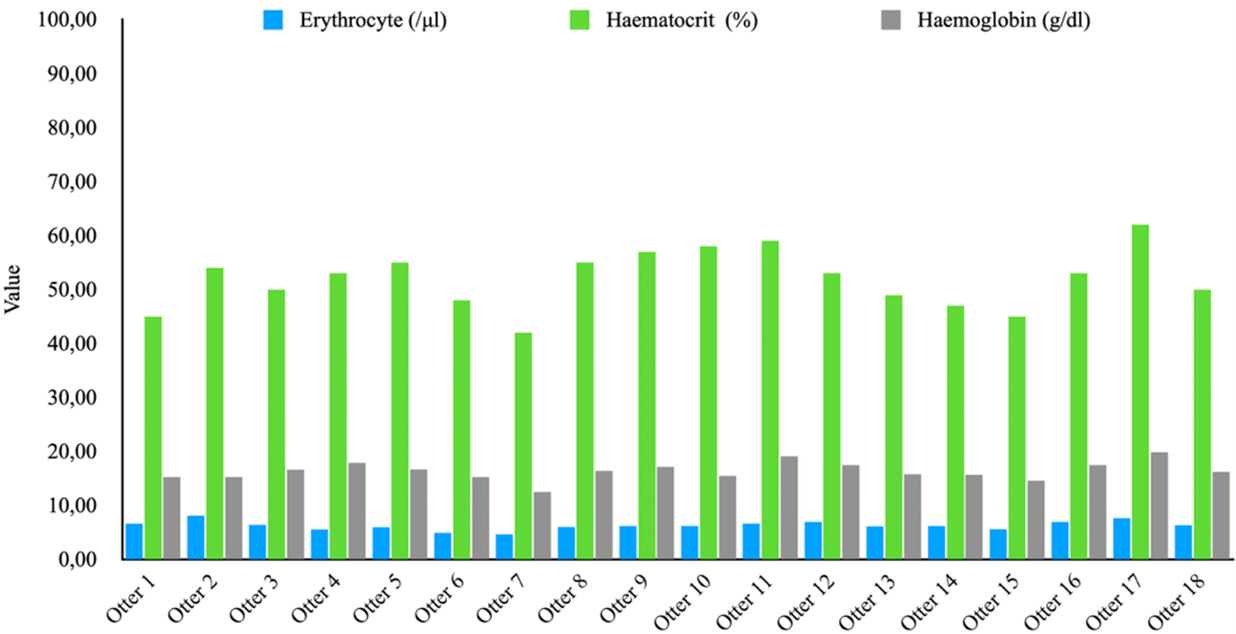
The erythrocyte counts ranged from approximately 4,500/μl to 8,000/μl, with most individuals falling within the expected range for wild carnivores. This indicates a generally healthy erythropoietic profile across the sample group. Haematocrit values varied between approximately 40% and 60%, with an average of around 50%. While most individuals showed values within the normal range, some outliers were observed, notably Otter 17 with a high value of about 60% and Otter 7 with a lower value of approximately 40%. These differences may reflect variations in hydration status or physiological adaptations such as haemoconcentration or haemodilution. Haemoglobin concentrations ranged from approximately 12 g/dl to 20 g/dl. Otter 17 exhibited one of the highest levels (~20 g/dl), while Otter 7 had one of the lowest (~12 g/dl). These values align with typical patterns observed in this species, although individual variability was evident.
Figure 2 is a radar chart that provides a comprehensive overview of the haematological profiles of Lontra longicaudis, focusing on three main parameters: red blood cell count (/µL), haematocrit (%), and haemoglobin concentration (g/dL). Each radial axis represents one of these parameters, allowing for a holistic comparison of their values across different individuals. Concentric circles within the chart indicate varying levels of each parameter, with higher values positioned further from the centre. This visualization provides a clear representation of blood composition in otters, highlighting the interplay between red blood cell counts, haematocrit percentages, and haemoglobin concentrations. By examining the shape and size of the enclosed area for each individual, we can identify patterns or deviations in their haematological profiles. For example, a larger area suggests higher overall values, while irregular shapes may indicate imbalances between parameters. This radar chart serves as an effective tool for summarizing and comparing the haematological status of multiple otters, providing information about their overall health and possible variations related to factors such as age, sex, or environmental conditions.
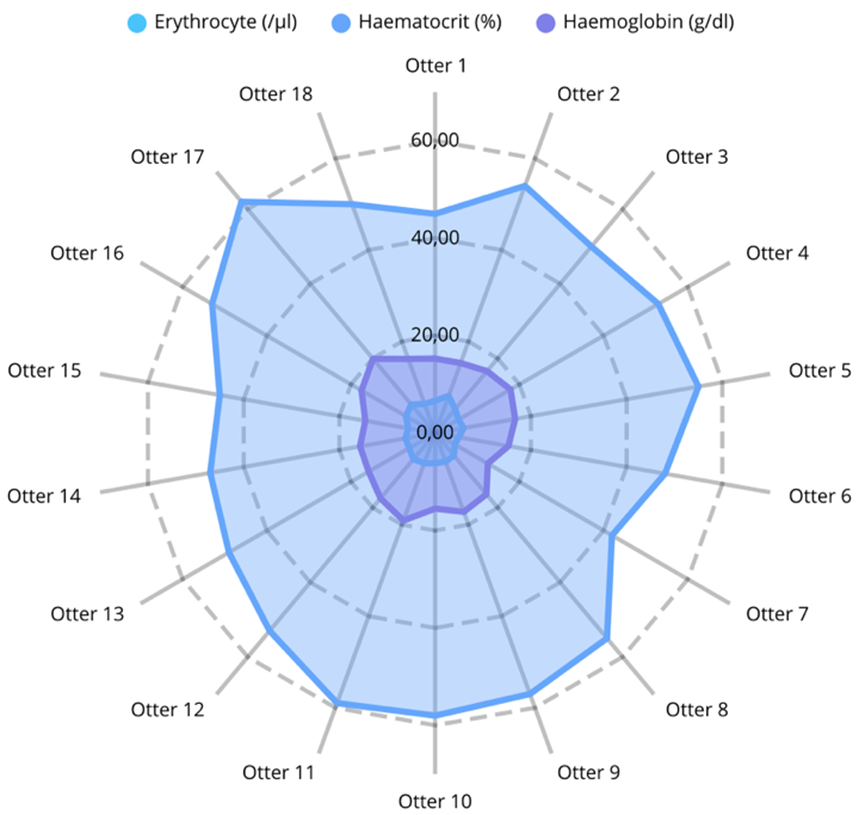
The erythrocyte values show a relatively homogeneous distribution within the sample. However, some individuals stand out for presenting higher counts, as in the case of Otter 2 and Otter 17, while others, such as individuals Otter 6 and Otter 7, show lower levels. In general, these values are within the expected range for wild carnivores, suggesting a haematological pattern compatible with good physiological health.
Regarding haematocrit, despite individual variation, most animals present percentages within the normal range for the species. However, Otter 17 stands out, which exhibits a considerably high value (approximately 60%), and Otter 7, with a lower value (around 40%). These differences may be associated with several physiological or environmental factors, such as hydration status or even adaptive responses to metabolic activity. Haematocrit reflects the proportion of blood volume occupied by erythrocytes and is therefore a relevant marker for identifying conditions such as haemoconcentration or anaemia.
Individuals like Otter 17 have high haemoglobin concentrations, reaching around 20 g/dl, while Otter 7 has a lower value, around 12 g/dl. Haemoglobin is responsible for transporting oxygen in the blood, and its levels are essential for assessing respiratory capacity and detecting possible clinical changes, such as anaemia or hyperoxygenation. Thus, these data reinforce the importance of individual analyses complemented by detailed clinical evaluation.
Although there are differences between individuals, the values generally remain within a range considered normal for carnivorous mammals. This suggests that the sample is in good physiological condition, with no clear evidence of widespread pathological deviations. A visual correlation between the erythrocyte, haematocrit and haemoglobin values can be observed.
For example, individuals with higher erythrocyte counts tend to also have higher haematocrit and haemoglobin values, reinforcing the consistency of the data. Some otters present extreme values, such as Otter 17, which has the highest haematocrit and haemoglobin values, and Otter 7, which has the lowest erythrocyte and haemoglobin values. These cases can be investigated in future studies to determine possible underlying causes.
The MCV (mean corpuscular volume) ranged from 75.56 fl and 96.77 fl, with a mean of 85.20 fl. This suggests that most erythrocytes were within normal sizes, with no clear evidence of macro or microcytosis in the population mean. The MCHC (mean corpuscular haemoglobin concentration) averaged 31.18 g/dl, with a range between 25.90 g/dl and 33.77 g/dl. These values reflect a haemoglobin concentration within the range considered normal for mammals, suggesting the absence of hypochromia on a population scale. With a mean of 25.75 pg, the MCH (mean corpuscular haemoglobin) indicates an adequate amount of haemoglobin per erythrocyte, reinforcing the interpretation of normochromia in the sample studied (Table 2).
MCHC (mean corpuscular haemoglobin concentration, g/dL), MCV (mean corpuscular volume, fL), and MCH (mean corpuscular haemoglobin, pg) are the primary objectives of the radar chart that has been demonstrated (Figure 3). These parameters are essential for evaluating the morphology and composition of red blood cells, which play a critical role in oxygen transport and overall health. Each radial axis represents one of these parameters, allowing for a comparative analysis across multiple otters.
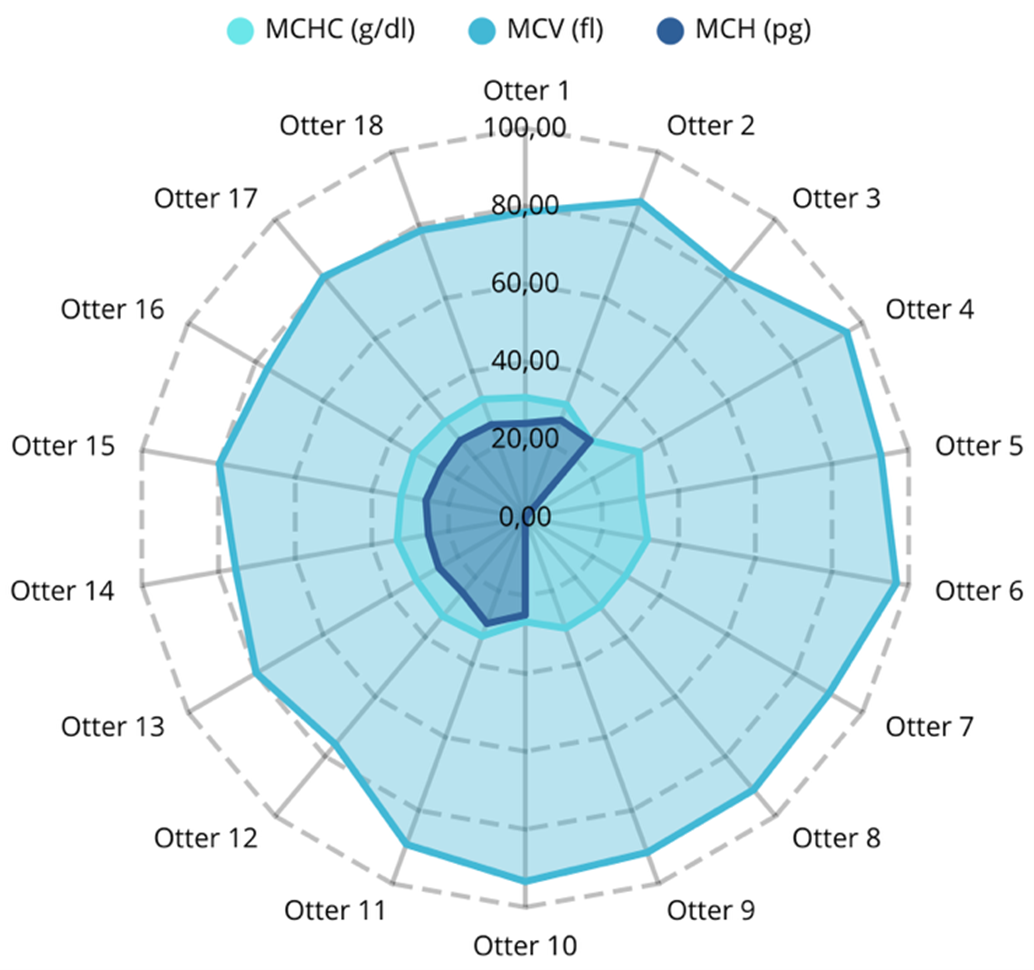
Each radial axis represents one of three parameters: MCHC (g/dL) which measures the average haemoglobin concentration in red blood cells, MCV (fL) which reflects the average size of red blood cells, and MCH (pg) which indicates the average amount of haemoglobin per cell. The coloured areas represent the average values of these parameters for different otters. MCHC is indicated by a light blue colour, MCV by a more intense blue colour, and MCH by a dark blue colour. The average values of each parameter are connected by lines, forming an “area” that summarizes the average haematologic profile.
The figure includes data from 18 individual otters, with each otter's profile represented by a distinct area within the radar plot. The concentric circles indicate varying levels of the parameters, with higher values positioned farther from the centre. Notably, while MCHC and MCV data are available for all individuals, MCH values are missing for Otters 4, 5, 6, 7, 8, and 9. This limitation is important to acknowledge, as it may affect the completeness of the comparison for these specific otters.
By examining the shape and size of the enclosed areas, we can identify patterns or deviations in the haematological profiles of the otters. For instance, larger areas suggest higher average values for the respective parameters, while irregular shapes may indicate imbalances among them. This visualization offers a holistic view of the blood cell characteristics in this species, enabling researchers to assess overall haematological health and detect potential anomalies related to factors such as age, sex, or environmental conditions.
MCV values range from approximately 75 fl to 96 fl. There is a relatively homogeneous distribution, with some individuals having higher values (such as Otter 4 and Otter 6) and others having lower values (such as Otter 12 and Otter 14). In general, these values are within the expected range for wild carnivores, indicating that most erythrocytes are of normal size.
The mean corpuscular haemoglobin concentration ranges from about 25 g/dL to 34 g/dL. There are some individual discrepancies, such as Otter 5, which has a slightly higher value (about 34 g/dL), while Otter 3 has a lower value (about 26 g/dL). These values reflect the amount of haemoglobin in each erythrocyte and are important for evaluating possible conditions of normochromia, hypochromia or hyperchromia.
MCH, the amount of haemoglobin per erythrocyte, ranges from approximately 24 pg to 29 pg. Some individuals have higher values (such as Otter 11, with approximately 29 pg), while others have lower values (such as Otter 1, with approximately 24 pg). These data provide information about the individual haemoglobin load in erythrocytes and are essential for identifying patterns of anaemia or other changes in cellular composition.
Although there are differences between individuals, the values generally remain within a range considered normal for carnivorous mammals. This suggests that the otter herd is in good physiological condition, with no clear evidence of widespread pathological deviations. A visual correlation can be observed between the MCV, MCHC, and MCH values. For example, individuals with higher erythrocyte volumes (MCV) also tend to have higher MCHC and MCH values, reinforcing the consistency of the data. These correlations highlight the interdependence of these haematological parameters, as larger red blood cells (higher MCV) are often associated with increased hemoglobin content (MCH) and concentration (MCHC). Such patterns further support the notion that the erythropoietic system of the otters is functioning effectively, contributing to their overall health and adaptability in captivity.
The data presented in Table 3 show more haematological parameters for the Lontra longicaudis herd. Similar to Table 2, the sample consists of 18 individuals, 9 females and 9 males. The average age is approximately 4.6 years, with a significant variation that includes very young pups (less than one year old) and adults (up to nine years old). This age range allows inferences about possible differences associated with development, although the small sample size limits more in-depth analyses.
Figure 4 is a radar chart visualizing the haematologic profiles of Lontra longicaudis, highlighting five important blood markers: lymphocytes (white blood cells responsible for the immune response), platelets (thousand/µl, cells involved in blood clotting), segmented (mature neutrophils), monocytes (white blood cells related to inflammation and cell clearance), and eosinophils (white blood cells associated with allergic and parasitic responses). Each radial axis in the chart represents one of these parameters, allowing an integrated analysis of the mean values for each individual.
However, it is important to note that the graph only reflects the available data, as some parameters were not measured for all otters. This limitation may affect the complete comparison between individuals, especially in cases where data are missing for certain markers. Despite this, the graph provides a clear overview of the average haematological profiles, making it easier to identify general patterns and possible individual deviations. The circular representation allows a quick comparison between the different cellular components of the blood, offering valuable insights into the immunological and haemostatic status of the otters.
The total leukocyte count ranged from 3.3 × 10³/μl to 12.2 × 10³/μl, with a mean of 5.91 × 10³/μl. This interval is within the range described for wild carnivores, suggesting an adequate basal immune status in most cases. However, the high value of Otter 14 (12.2 × 10³/μl) stands out, which may indicate an inflammatory response or subclinical infection. This animal also presents a marked increase in segmented neutrophils (7,320/μl), reinforcing this hypothesis.
Segmented neutrophil counts ranged from 1,980/μl to 7,320/μl, with a mean of 3,771.27/μl. The predominance of segmented neutrophils reflects the adaptive immune response to acute or chronic aggressors. The case of Otter 14, once again, stands out as a possible inflammatory outlier. Only Otter 9 has high levels of band neutrophils (75/μl), while the others have values close to zero. The presence of band neutrophils indicates a recent or ongoing infectious process, deserving specific clinical attention in this individual.
The average lymphocyte count is 1,381.47/μl, with a range between 351/μl and 2,928/μl. Lymphocytes remain within the expected normal range, suggesting maintenance of a functional cellular immune response. However, some individuals have high values, such as Otter 6 (2,928/μl), which may be associated with viral or immunomodulatory processes.
With an average of 272.13/μl, monocytes show considerable variation, with a maximum peak in Otter 14 (976/μl) and a minimum in Otter 6 (61/μl). Elevated levels may be indicators of chronic inflammation or intracellular infections, such as persistent protozoa or bacteria.
The mean eosinophil count was 1,127.71/μl, with emphasis on Otter 14 (2,562/μl) and Otter 4 (1,760/μl). Elevated eosinophils are frequently associated with parasitosis, allergies or immune responses against helminths, suggesting the need for parasitological investigation in these animals.
Basophils were practically absent in the sample, with an average of only 0.01/μl, which is consistent with patterns observed in wild mammals. Their rarity in the peripheral circulation limits their diagnostic relevance in routine.
Platelet counts range from 275,000/μl to 735,000/μl, with an average of 461.17 thousand/μl. These values are within the normal range for carnivores, with no evidence of generalized thrombocytopenia or thrombocytosis. However, Otter 7 has the highest value (735,000/μl), which may be related to inflammatory or hypercoagulable processes.
The mean total protein concentration was 7.43 g/dL, ranging from 6.0 g/dL to 9.0 g/dL. These values indicate reasonable metabolic homeostasis, although some individuals have low levels, such as Otter 2 (6.0 g/dL), possibly associated with nutritional deficiencies or protein losses.
The haematologic data presented here provide a comprehensive overview of the immunological and metabolic status of a representative sample of otters. Although most parameters are within the expected range for carnivores, some individuals stand out for deviations that may have relevant clinical implications.
Otter 14, for example, with simultaneous elevations in total leukocytes, segmented neutrophils, monocytes, and eosinophils, appears to be presenting a systemic inflammatory response, possibly associated with bacterial or parasitic infection. Otter 9, with elevated band neutrophils, suggests a recent or early-stage infectious process, deserving closer monitoring.
On the other hand, Otter 6, with marked lymphocytosis, may be experiencing an active viral or immunological condition. Otter 7, with increased platelets and moderate eosinophilia, should be investigated for causes of hypercoagulability and parasitic infestations. These findings illustrate the importance of integrating laboratory data with detailed clinical examinations, epidemiological history, and environmental assessment, especially in species that are difficult to manage and monitor.
DISCUSSION
The results obtained in this study represent a significant advance in the understanding of the haematological profile of Lontra longicaudis kept in captivity. They provide essential reference values for clinical evaluation, health monitoring and planning of conservation strategies for this endangered species in the Atlantic Forest biome. The sample, comprised of 18 individuals, with ages ranging from pups to adults, males and females, allowed the evaluation of physiological variations associated with the stage of development. However, the small sample size limits deeper inferences about differences related to sex or environment.
The mean erythrocyte (6.30 million/μl), haematocrit (51.94%) and haemoglobin (16.39 g/dl) counts were within the expected range for wild carnivores, indicating adequate oxygen transport capacity and good hematopoietic function. These data corroborate those found by Johnstone et al. (2017), who highlighted the importance of these parameters as general indicators of health and physical condition in aquatic mammals. The variation observed between individuals can be explained by factors such as hydration, level of metabolic activity and possible adaptations to life in captivity. Individuals such as Otter 17 showed high levels of these parameters, suggesting an adaptive response to increased physiological demand, while Otter 7 showed lower values, possibly reflecting suboptimal nutritional conditions or compromised clinical status.
The haematometric indices, MCV (85.20 fl), MCHC (31.18 g/dl) and MCH (25.75 pg), reinforced the normocytic and normochromic pattern in most cases, indicating the absence of microcytic or hypochromic anaemias on a population scale. However, some individuals, such as Otter 13 and Otter 5, presented deviations in the values of these markers, which deserves further investigation, especially regarding nutritional deficits or underlying inflammatory processes. Similar studies in other semiaquatic mustelid species have also demonstrated interindividual variations associated with environmental and dietary factors (Serfass et al., 1993).
Regarding leukocyte parameters, the mean total leukocyte count (5.91 × 10³/μl) was within the normal range for wild carnivores, indicating an adequate basal immune status in most animals. However, individual Otter 14 stood out with an elevated count (12.2 × 10³/μl), along with a simultaneous increase in segmented neutrophils (7,320/μl), monocytes (976/μl), and eosinophils (2,562/μl). This pattern suggests a systemic inflammatory response, potentially associated with bacterial or parasitic infection. Indeed, marked eosinophilia may be linked to helminthic infestations or allergic reactions, as described by Krasner et al. (2024) in studies with otters exposed to environmental contaminants.
Otter 9, in turn, presented an increase in neutrophils (75/μl), indicative of a recent or ongoing infectious process, highlighting the need for closer clinical monitoring. Otter 6 exhibited elevated lymphocytosis (2,928/μl), compatible with a viral condition or immune hyperactivity, as reported by Rodrigues et al. (2013) in otter populations under different environmental pressures. These findings illustrate the importance of integrating laboratory data with clinical and epidemiological history, especially in species that are difficult to manage and monitor.
Platelets (mean 461.17 thousand/μl) remained within normal limits, except in the case of Otter 7, whose high value (735 thousand/μl) may be associated with inflammatory or hypercoagulable processes. Although thrombocytosis is not pathognomonic of any specific condition, its isolated appearance or associated with other inflammatory markers should be considered in future evaluations. Total protein concentration (7.43 g/dl) was also consistent with reasonable metabolic homeostasis, although some individuals had lower levels, such as Otter 2 (6.0 g/dl), possibly reflecting protein deficit or renal/protein loss.
Despite the general homogeneity of the data, it is important to emphasize that life in captivity can induce physiological and behavioural changes that influence haematological profiles. Factors such as controlled diet, reduced environmental stress, and lower exposure to natural pathogens can contribute to maintaining more stable parameters compared to free-ranging populations. However, the counterpoint is the greater susceptibility to emerging diseases and metabolic disorders resulting from the lack of dietary variability and space limitation (Reed-Smith and Larson, 2017). Additionally, the absence of natural stimuli and restricted opportunities for exploration may lead to behavioural alterations, such as increased stereotypic behaviours or reduced physical activity, which can further impact haematological and metabolic markers. These factors underscore the importance of designing enriched captive environments that mimic natural conditions as closely as possible to promote both physical and psychological well-being.
This study therefore fills a critical gap in the scientific literature on Lontra longicaudis, providing an initial basis for future comparative work between captive and natural populations. Obtaining data in different geographic contexts and life stages will be essential to consolidate more robust reference values and better understand the interactions between environmental, physiological and immunological factors in this iconic species. In addition, the standardization of collection, analysis, and laboratory interpretation protocols will favour the creation of specific guidelines for health management, early diagnosis of diseases and success in reintroduction programs.
CONCLUSIONS
The main objective of this study was to establish reference values for the haematological profile of Lontra longicaudis kept in captivity, contributing to conservation strategies, clinical monitoring and planning of reintroduction programs. From the analysis of 18 individuals, representative data of blood parameters were obtained, revealing general averages of 6.30 million/μl of erythrocytes, 51.94% of haematocrit and 16.39 g/dl of haemoglobin, within the expected range for wild carnivores.
The haematometric indices (MCV: 85.20 fl; CHCM: 31.18 g/dl; MCH: 25.75 pg) indicated a normocytic and normochromic pattern in most cases, reinforcing the absence of micro or macrocytic anaemias on a population scale. In turn, the leukocyte parameters (mean of 5.91 × 10³/μl) suggested an adequate basal immunological status, although some individuals presented alterations suggestive of inflammatory processes, subclinical infections or active immune responses, as in the case of Otter 14 and Otter 6. The platelet count (461.17 thousand/μl) and total proteins (7.43 g/dl) reflected reasonable metabolic homeostasis, with specific exceptions that highlight the importance of individual evaluation complemented by detailed clinical examinations.
These findings provide an essential basis for understanding the physiology of this endangered species, filling a critical gap in the scientific literature and offering support for laboratory diagnostics, health management and reintroduction protocols. In addition, the study highlights the need for future investigations into variations associated with the natural environment, life stages and possible influences of life in captivity on haematological profiles. Thus, the results have practical relevance for veterinary medicine and theoretical implications for the ecology and conservation of semiaquatic carnivores, especially the neotropical otter.
REFERENCES
Carvalho Junior, O. de O., and Birolo, A. B. (2024). Mudança climática e impactos em populações de lontra neotropical. Peer Review, 6(8), Artigo 8. https://doi.org/10.53660/PRW-2095-3826
Carvalho-Junior, O. de O., Tosatti, M. A., Barbosa, P. M., Schmidt, A., Esteves, P. dos S., and Birolo, A. B. (2022). Neotropical otter population strengthening in the wild. Brazilian Journal of Animal and Environmental Research, 5(2), Artigo 2. https://doi.org/10.34188/bjaerv5n2-088
Carvalho-Junior, Oldemar, Birolo, Alesandra Bez, and Macedo-Soares, Luis. (2010). Ecological Aspects of Neotropical Otter (Lontra longicaudis) in Peri Lagoon, South Brazil. IUCN Otter Spec. Group Bull., 27(2), 105–115. https://www.iucnosgbull.org/Volume27/Vol27_Iss2_Index.html
Johnstone, C. P., Lill, A., and Reina, R. D. (2017). Use of erythrocyte indicators of health and condition in vertebrate ecophysiology: A review and appraisal. Biological Reviews, 92(1), 150–168. https://doi.org/10.1111/brv.12219
Krasner, A., Stolen, M., Rotstein, D., and Fire, S. (2024). Contaminant Exposure and Liver and Kidney Lesions in North American River Otters in the Indian River Lagoon, Florida. Toxics, 12(9), Artigo 9. https://doi.org/10.3390/toxics12090684
Quintela, F. M., Porciuncula, R. A., and Colares, E. (2008). Diet of Lontra longicaudis (Olfers) in a coastal stream in southern Rio Grande do Sul State, Brazil. Neotrop. Biol. Cons., 3(3), 119–125. https://doi.org/10.4013/5454
Reed-Smith, J., Larson, S. (2017). Otters in Captivity. In: Butterworth, A. (eds) Marine Mammal Welfare. Animal Welfare, vol 17. Springer, Cham. ISBN: 978-3-319-46993-5 https://doi.org/10.1007/978-3-319-46994-2_31
Rodrigues, L. de A., Leuchtenberger, Caroline, Kasper, Carlos Benhur, Carvalho Junior, Oldemar de Oliveira, and Silva, Vania Fonseca. (2013). Avaliação do risco de extinção da Lontra neotropical Lontra longicaudis (Olfers, 1818) no Brasil. Biodiversidade Brasileira, 3(1), 216–227. https://doi.org/www.researchgate.net/publication/258629550
Rosas-Ribeiro, P. F., Rosas, F. C. W., Amaral, R. S., Fettuccia, D. de C., and Brum, S. (2024). Amazonian Aquatic Mammals: Existing Knowledge, Current Threats and Future Studies. In W. R. Spironello, A. A. Barnett, J. W. Lynch, P. E. D. Bobrowiec, and S. A. Boyle (Eds.), Amazonian Mammals: Current Knowledge and Conservation Priorities (p. 181–213). Springer International Publishing. ISBN: 978-3-031-43070-1 https://doi.org/10.1007/978-3-031-43071-8_7
Serfass, T. L., Peper, R. L., Whary, M. T., and Brooks, R. P. (1993). River Otter (Lutra canadensis) Reintroduction in Pennsylvania: Prerelease Care and Clinical Evaluation. Journal of Zoo and Wildlife Medicine, 24(1), 28–40. https://www.jstor.org/stable/20460311
Résumé: Profil Hématologique des Loutres à Longue Queue (Lontra longicaudis)
Cette étude visait à établir des valeurs de référence pour le profil hématologique de Lontra longicaudis gardée en captivité, contribuant ainsi à l’évaluation clinique, au suivi sanitaire et aux stratégies de conservation de cette espèce menacée. Des échantillons de sang ont été prélevés sur 18 individus d’âges variés (des loutrons aux adultes) et des deux sexes, permettant une première évaluation de la variabilité physiologique. Les résultats ont révélé un nombre moyen d’érythrocytes de 6,30 millions/μl, un hématocrite de 51,94 % et une concentration d’hémoglobine de 16,39 g/dl, tous dans les limites attendues pour les carnivores sauvages. Les indices hématométriques ont fourni un profil normocytaire et normochrome chez la plupart des individus. Le nombre moyen de leucocytes était de 5,91 x10³/μl, les neutrophiles étant le type cellulaire prédominant, suggérant un statut immunitaire stable chez la majorité des animaux. Cependant, certains individus présentaient des anomalies notables, comme « Otter 14 », qui présentait une leucocytose, une neutrophilie, une monocytose et une éosinophilie, indiquant peut-être un processus inflammatoire ou infectieux. La numération plaquettaire et les taux de protéines totales étaient généralement dans les limites normales, bien que des cas isolés de thrombocytose et d’hypoalbuminémie aient été observés. Ces résultats fournissent des données de référence pour de futures études comparatives entre populations captives et en liberté. Malgré la taille limitée de l’échantillon, cette recherche comble une lacune importante dans la littérature et soutient le développement de protocoles ciblés de gestion sanitaire pour Lontra longicaudis. L’établissement de ces valeurs de référence améliore la capacité de détection précoce des maladies, améliore les soins vétérinaires et renforce les initiatives de conservation de cette espèce aquatique clé des écosystèmes néotropicaux..
Revenez au dessus
Resumen: Perfil Hematológico de la Nutria Neotropical (Lontra longicaudis)
Este estudio tuvo como objetivo establecer valores de referencia para el perfil hematológico de Lontra longicaudis mantenida en cautiverio, contribuyendo a la evaluación clínica, el monitoreo de la salud, y las estrategias de conservación para esta especie amenazada. Colectamos muestras de sangre de 18 individuos de distintas edades (desde crías hasta adultos) y de ambos sexos, lo que permitió una evaluación inicial de la variabilidad fisiológica. Los resultados revelaron conteos promedio de eritrocitos de 6.30 millones/μl, hematocrito de 51.94%, y concentración de hemoglobina de 16.39 g/dl, todos valores dentro de los rangos esperados para carnívoros silvestres. Los índices hematométricos indicaron un patrón normocítico y normocrómico en la mayoría de los individuos. Los conteos de leucocitos promediaron 51.94 x 10³/ μl, con los neutrófilos siendo el tipo celular dominante, lo que sugiere un status inmunitario estable en la mayoría de los animales. Sin embargo, algunos individuos exhibieron desviaciones notables, como la Nutria 14, que mostró leucocitosis, neutrofilia, monocitosis, y eosinofilia, lo que posiblemente indica un proceso inflamatorio o infeccioso. Los conteos de plaquetas y los niveles de proteínas totales estuvieron generalmente dentro de límites normales, aunque observamos casos aislados de trombocitosis e hipoalbuminemia. Estos hallazgos proporcionan datos de base para futuros estudios comparativos entre poblaciones en cautiverio y en estado silvestre. A pesar del limitado tamaño muestral, esta investigación viene a llenar un vacío crítico en la literatura y da apoyo al desarrollo de protocolos de manejo sanitario dirigidos para Lontra longicaudis. El establecimiento de estos valores de referencia aumenta la capacidad para la detección temprana de enfermedades, mejora el cuidado veterinario, y fortalece las iniciativas de conservación para esta especie acuática clave de los ecosistemas neotropicales.
Vuelva a la tapa
Resumo: Perfil Hematológico dDe Lontras Neotropicais (Lontra longicaudis)
Este estudo teve como objetivo estabelecer valores de referência para o perfil hematológico de Lontra longicaudis mantidas em cativeiro, contribuindo para a avaliação clínica, monitoramento da saúde e estratégias de conservação dessa espécie ameaçada. Amostras de sangue foram coletadas de 18 indivíduos de diferentes idades (de filhotes a adultos) e de ambos os sexos, permitindo uma avaliação inicial da variabilidade fisiológica. Os resultados revelaram contagens médias de eritrócitos de 6,30 milhões/µl, hematócrito de 51,94% e concentração de hemoglobina de 16,39 g/dl, todos dentro das faixas esperadas para carnívoros selvagens. Os índices hematimétricos indicaram um padrão normocítico e normocrômico na maioria dos indivíduos. As contagens de leucócitos apresentaram média de 5,91 x10³/µl, com neutrófilos como o tipo celular predominante, sugerindo um estado imunológico estável na maioria dos animais. No entanto, alguns indivíduos apresentaram desvios notáveis, como a Lontra 14, que exibiu leucocitose, neutrofilia, monocitose e eosinofilia, possivelmente indicando um processo inflamatório ou infeccioso. As contagens de plaquetas e os níveis de proteína total estavam geralmente dentro dos limites normais, embora casos isolados de trombocitose e hipoalbuminemia tenham sido observados. Esses achados fornecem dados de base para futuros estudos comparativos entre populações em cativeiro e em vida livre. Apesar do tamanho limitado da amostra, esta pesquisa preenche uma lacuna crítica na literatura e apoia o desenvolvimento de protocolos de manejo de saúde direcionados para Lontra longicaudis. O estabelecimento desses valores de referência amplia a capacidade de detecção precoce de doenças, melhora os cuidados veterinários e fortalece as iniciativas de conservação dessa espécie aquática-chave nos ecossistemas neotropicais.
Voltar ao começo



